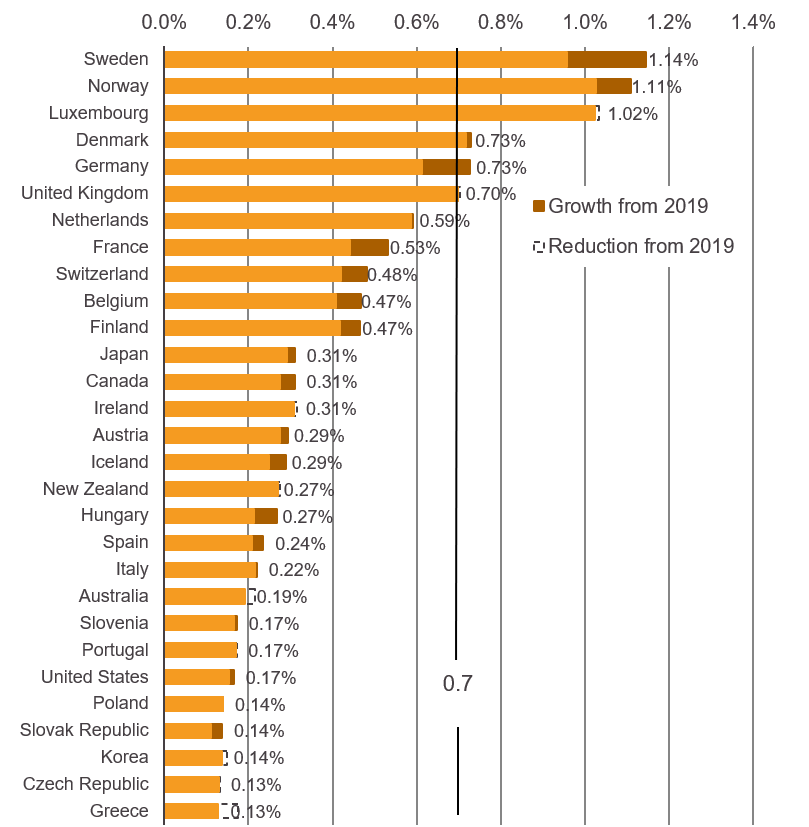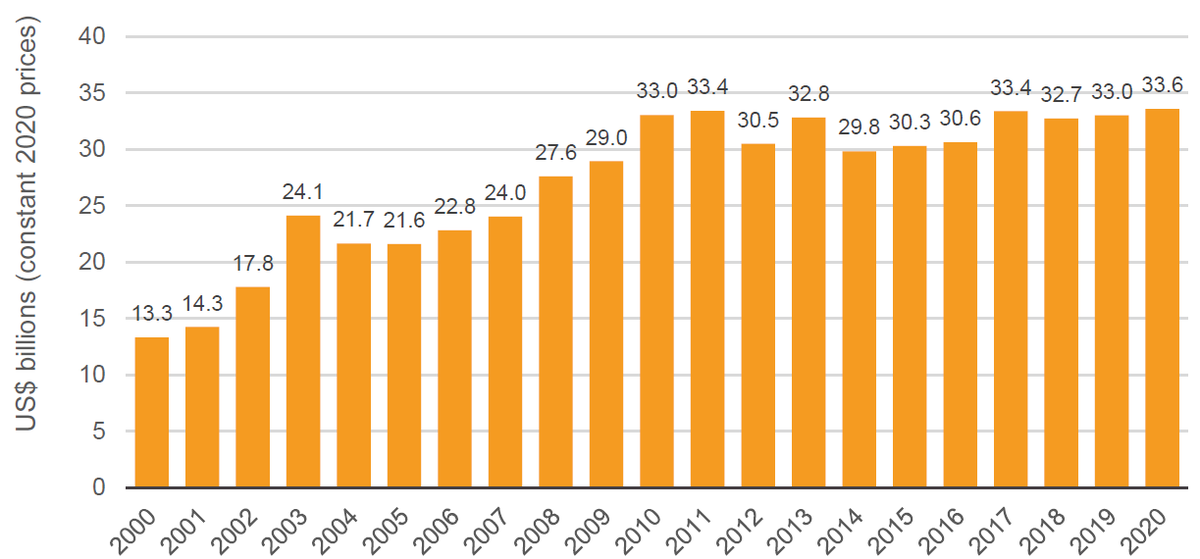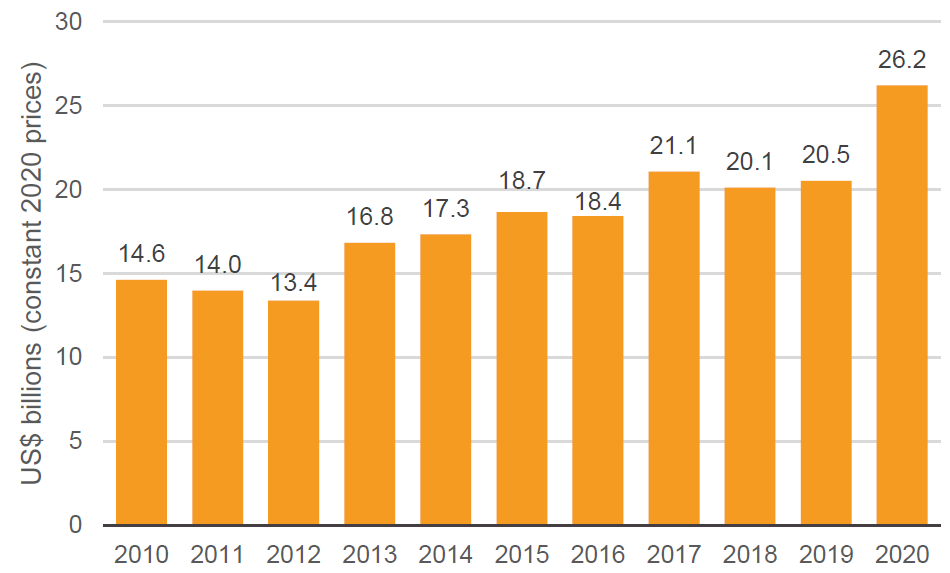ODA in 2020: What does OECD DAC preliminary data tell us?
Analysis of the OECD DAC’s preliminary 2020 ODA (aid) data. Read about trends in aid, including which donors increased or cut contributions, aid to LDCs, and changes in grants versus loans.
DownloadsIntroduction
This factsheet looks at trends in aid from the preliminary release of OECD Development Assistance Committee (DAC) official development assistance (ODA) data for 2020. The data shows us how aid changed in 2020, a year in which the world faced an unprecedented challenge from the Covid-19 pandemic, which has had serious development effects.
The picture is more challenging for poorer countries, as progress is reversed while poverty and inequality rise. At the end of 2020, there were an estimated 737 million people living in extreme poverty as the pandemic – and its economic and social effects – reversed decades of progress, pushing over 100 million people into extreme poverty.
ODA is a vital resource for supporting those most in need and countering these negative trends. Making the best use of this resource will be fundamental to mitigating the worst effects of the current crisis and promoting renewed progress towards achieving Agenda 2030. Aid increased in 2020 by 3.5%, to reach US$161 billion – an all-time high; however, support to the least developed countries (LDCs) increased by only 1.8%.
While some donors stepped up their contributions, with notable increases coming from Germany (US$3.4 billion), the US (US$1.6 billion), France (US$1.4 billion) and Canada (US$361 million) there were also cuts from almost half of DAC donors including the UK (US$2.1 billion), which is particularly significant as the UK has been one of the largest donors.
Bilateral aid in the form of loans and equity investments from DAC donors increased by 28% in 2020, reaching US$26.2 billion (up from US$20.5 billion in 2019) just as concerns grow about a new debt crisis. While we do not yet know what proportion of ODA loans have gone to LDCs in 2020, we do know that between 2010 and 2019 bilateral ODA loans to LDCs grew 5-fold, while grants were cut by 9%, and so it is likely this increase in ODA lending will mean more loans to countries with less ability to repay debt.
Key facts
- In 2020, official development assistance (ODA) increased by 3.5%, to its highest-ever level of US$161 billion (Figure 1)
- The number of donors achieving the 0.7% ODA/GNI target increased to six donors in 2020 (Figure 2)
- ODA to the most vulnerable countries increased only slightly between 2019 and 2020: by 1.8% (US$557 million), to reach US$33.6 billion (Figure 3)
- Gross ODA lending by DAC donors was up by 79% from 2010 (while grants grew 12% over the same period), despite warnings of a new debt crisis (Figure 4)
ODA reaches a new high of US$161 billion in 2020, due in part to the response to the pandemic
Figure 1: ODA disbursements in 2020 increase by 3.5% to reach US$161 billion

A bar chart showing that official development assistance disbursements in 2020 increased by 3.5% to reach 161 billion US dollars.
Source: OECD DAC.
Notes: ODA = official development assistance. The chart shows net ODA and grant equivalent ODA for the years in which they respectively represented headline ODA. The difference between the old (net ODA) and new (grant equivalent) measure is attributed to the way that ODA loans are accounted for; under the old measure the full face value of the loan is reported with loan repayments subtracted, while under the new measure only the grant equivalent of the loan is reported (and loan repayments are not subtracted).
- Using the grant-equivalent ODA measure, total ODA increased by US$5.4 billion or 3.5% in real terms between 2019 and 2020, to reach US$161 billion.
- In 2020, ODA reached its highest level ever due in part to support for the Covid-19 crisis. From 2016 to 2019, there was very limited growth in global aid flows. This trend changed due to the crises caused by the pandemic, from the immediate health crisis to the deep socioeconomic crises, leading donor countries overall to increase global aid levels more significantly.
- Notable increases between 2019 and 2020 were recorded by Germany (US$3.4 billion), the US (US$1.6 billion), France (US$1.4 billion) and Sweden (US$927 million).
- Notable decreases between 2019 and 2020 were reported by the UK (US$2.1 billion), Italy (US$320 million) and Australia (US$304 million).
- The number of DAC donors reporting an increase was 16 out of 29.
- The number of DAC donors reporting a decrease was 13 out of 29.
Germany reaches the 0.7% target again while other donors maintain their aid levels in 2020
Figure 2: Six donors give at least 0.7% of GNI as ODA in 2020

A stacked bar chart showing that six donors gave at least 0.7 percent of gross national income as official development assistance in 2020.
Source: OECD DAC.
Notes: ODA = official development assistance. The ODA/GNI percentage shown in the chart is based on grant-equivalent ODA.
- In 2020, six donors achieved an ODA/GNI level of 0.7% or higher: Luxembourg, Germany, the UK, Norway, Sweden and Denmark.
- Germany re-joined the group with an increase in ODA/GNI level from 0.61% in 2019 to 0.73% in 2020. Germany last reached 0.7% ODA/GNI in 2016.
- Sweden, Norway and Denmark were already above the ODA/GNI 0.7% threshold in 2019, and further increased their shares in 2020. Sweden’s share grew from 0.96% in 2019 to 1.14% in 2020; Norway’s share grew from 1.03% to 1.11%.
- 20 out of 29 DAC donors recorded increases in levels of ODA/GNI between 2019 and 2020. Outside those hitting 0.7%, notable increases were seen for France (0.44% to 0.53%), Switzerland (0.42% to 0.48%), Belgium (0.41% to 0.47%) and Finland (0.42% to 0.47%).
- Nine DAC donors saw decreases in ODA/GNI levels. These included Greece (0.18% to 0.13%) and Australia (0.21% to 0.19%). A number of these decreases were marginal, such as the UK, which remained in the 0.7% group.
- The impact of Covid-19 on donor GNI has led to certain cases of reduced GNI levels between 2019 and 2020. For example, the UK’s GNI fell by 9% between 2019 and 2020, while its aid fell 10%. The UK still met the 0.7% GNI target in 2020, despite a fall in volume of aid.
ODA to the most vulnerable countries increases but sees lower growth than total ODA
Figure 3: ODA to least developed countries grows just above its 2011 peak

A bar chart showing that official development assistance to least developed countries grew in 2020 to just above its 2011 peak, reaching 33.6 billion US dollars.
Source: OECD DAC.
Notes: ODA = official development assistance. Data on ODA to least developed countries (LDCs) is available on only a net ODA basis. Germany and Greece failed to report how much of their ODA went to LDCs in 2020 so, in the absence of complete data, this chart assumes that Germany and Greece gave the same proportion of support to LDCs in 2020 as they did in 2019 and applies this proportion to their 2020 net ODA levels. Data refers to bilateral Development Assistance Committee (DAC (OECD)) members including EU institutions.
- ODA to the most vulnerable countries has narrowly increased between 2019 and 2020, by 1.8% (or US$557 million) to reach US$33.6 billion.
- At the donor level, notable increases were recorded from Japan (by 29% from US$3.6 billion to US$4.6 billion), EU institutions (by 18% from US$4.1 billion to US$4.9 billion), and France (by 28% from US$1.5 billion to US$2 billion) which drove the aggregate volume of ODA to LDCs to the highest level ever.
- Three donors are estimated to give over 30% of their bilateral net ODA to LDCs: Korea, Luxembourg and Japan.
- At the donor level, there were notable decreases in ODA to LDCs from the UK (a decrease of US$751 million or 20%), the US (a decrease of US$437 million or 4%) and Denmark (US$151 million or 29%).
- If EU institutions are excluded from the analysis, combined ODA from DAC country donors is estimated to have narrowly decreased between 2019 and 2020, by 0.6%.
Gross ODA lending by DAC donors up by over 79% since 2010, despite warnings of a new debt crisis
Figure 4: ODA loans and equity investments from DAC country donors grew 28% between 2019 and 2020

A chart showing that official development assistance loans and equity investments from Development Assistance Committee country donors grew by 28 percent between 2019 and 2020.
Source: OECD DAC.
Notes: ODA = official development assistance. DAC = Development Assistance Committee (OECD). Data includes ODA loans and equity investment. Data refers to bilateral ODA from DAC country donors.
- Loans and equity investments, as a component of ODA, have risen rapidly in recent years. Bilateral lending from DAC donors reached US$26.2 billion in 2020, from US$20.5 billion in 2019.
- The vast majority of bilateral lending is carried out by a handful of DAC members. The rise in 2020 ODA loans and equity was affected by an increase in loans by some donors, particularly France (an increase of US$2.6 billion or +55%), Germany (an increase of US$970 million or +21%) and Japan (an increase of US$1.7 billion or +18%). These three donors collectively accounting for 93% of new gross lending in 2020.
- Bilateral ODA loans and equity grew by 79% between 2010 and 2020, while grants grew 12% over the same period.
- The shift from grants to loans has been most pronounced in the poorest countries. Data for 2020 on the targeting of loans and equity will not be available until the end of 2021. However, in LDCs, bilateral ODA in the form of loans from DAC country donors grew over five-fold between 2010 and 2019, from US$586 million to US$3.2 billion, while grants were cut by 9%, from US$28.4 billion to US$25.9 billion.
Downloads
Related content
The impact of Covid-19 on aid: Financing an equitable recovery
This 2021 ECOSOC Forum on Financing for Development side-event shed light on the financing challenges that have been exacerbated by the pandemic and explored what needs to change in financing to promote an equitable response and recovery.
Aid data 2019–2020: Analysis of trends before and during Covid
What key shifts in donors, sectors, targeting and loans during the Covid pandemic are highlighted by new DAC data on 2019 ODA and 2020 aid figures from IATI?
How is aid changing in the Covid-19 pandemic?
This briefing sets out near real-time data on aid for the first half of 2020. It shows how commitments are changing in the Covid-19 pandemic and where these are most likely to affect the poorest people and places.